

Paul Maric
This Tesla self-drove me 50km to Bunnings on its own (almost)
6 Days Ago
While the HiLux continues to light up the sales charts, the Fortuner has long been the unloved twin – does it deserve better?

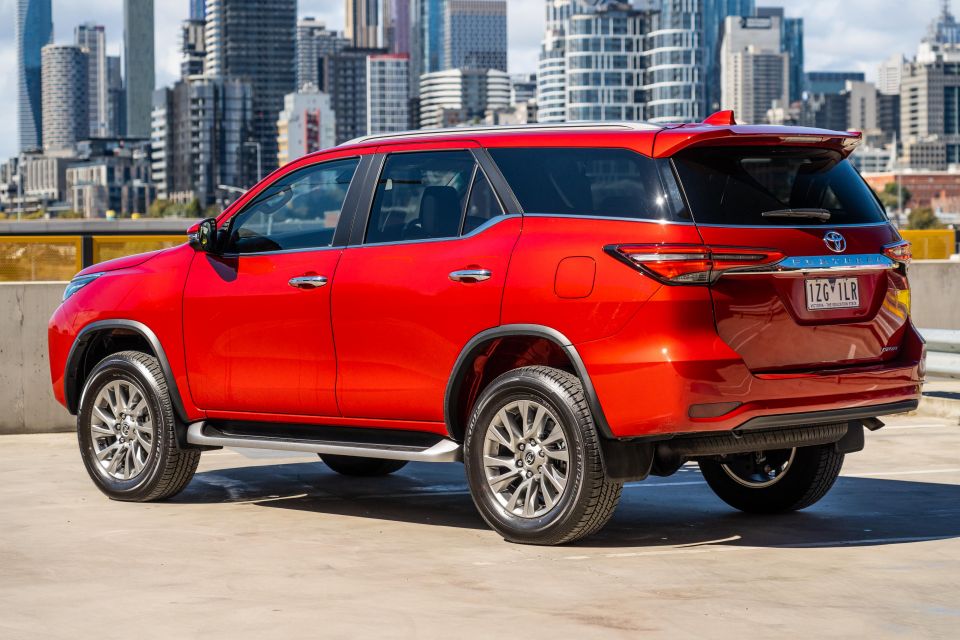

Quickly see how this car stacks up against its competition. Select any benchmark to see more details.
Where expert car reviews meet expert car buying – CarExpert gives you trusted advice, personalised service and real savings on your next new car.
Given the Toyota HiLux has long been Australia’s favourite new vehicle (until the Ford Ranger supplanted it last year), you’d think an SUV version would be a sure-fire hit – well, you’d be wrong.

Note: This article is based on our most recent review of the Fortuner, as there have been no major changes to pricing or specifications since its publication.
We have updated the article with the most up to date information available, and you can read our most recent pricing and specs article here.
WATCH: Paul’s video review of the 2021 Toyota Fortuner Crusade
While popular in other parts of the world, the Toyota Fortuner has never had the same love from Australians as the ute on which it’s based, despite incorporating virtually identical mechanicals as well as wearing the coveted Toyota logo on its nose.
For context, Toyota registered 3619 sales of the Fortuner in 2023, equating to a miniscule 2.9 per cent share of the sub-$70,000 large SUV market segment. The Ford Everest, meanwhile, notched up 15,071 registrations and an 11.9 per cent share.
Perhaps part of the problem is the fact Toyota also offers the far more popular LandCruiser Prado in the same segment, which for a bit more money brings more refinement and a bespoke design, in addition to a bigger and plusher cabin. And with an all-new Prado imminent, the gap between the two nameplates is likely to widen.
So with that in mind, why should you buy a Fortuner?

Well, the Toyota Fortuner Crusade on test here is the cream of the crop, being the absolute flagship and arguably the most luxurious take on the Fortuner/HiLux formula.
If you’re in the market for a solid off-roader and not in need of a tray, could this upmarket Fortuner be a better bet than a HiLux SR5 or Rogue, or other more expensive rivals like the Ford Everest? And does it deserve a bit more love from the Australian buying public? Read on to find out.
While the Fortuner range opens at just under $54,000 before on-roads, the flagship Crusade on test here lists for $66,755 plus on-road costs.

| Model | Price before on-road costs |
|---|---|
| Toyota Fortuner GX 4×4 | $53,775 |
| Toyota Fortuner GXL 4×4 | $58,895 |
| Toyota Fortuner Crusade 4×4 | $66,755 |
To see how the Fortuner lines up against the competition, check out our comparison tool.
Unlike most ute-based SUVs that effectively carry over their commercial vehicle cabins, the Fortuner gets unique interior bits compared to the HiLux.

Everything from the steering wheel to the buttons and controls are generally the same, but the Fortuner sports a more car-like cockpit with a better integrated touchscreen and an upright centre stack that blends HiLux and Prado designs together.
You also get more upmarket, padded materials like some stitched elements on the dashboard, either side of the centre console where your knee comes to rest, as well as trimming atop the instrument cluster.
Carryover elements from the HiLux include the telescopically-adjustable multifunction steering wheel, as well as the gear shifter, 4×4 dial, climate control cluster, front tweeters near each side mirror, and A-pillar grab handles.
It all feels solid, if a little old-school and dated in areas. The clunky gated automatic shifter and thick manual handbrake lever are examples of the platform’s advancing age, as is the fake woodgrain trim – which I don’t mind…




The Fortuner is nowhere near as digitised as the Japanese brand’s latest products, like the incoming next-gen Prado.
The blue-coloured analogue dials are a nice flash of colour compared to the related HiLux, and the multifunction display in the middle offers key information but also harks back to Toyota and Lexus models of old.
Meanwhile, the central infotainment system is still running older software, meaning it has wired Apple CarPlay and Android Auto and slower hardware that leaves a little to be desired alongside something like an Everest. It does retain physical buttons and dials for various shortcuts and controls, which makes it easy to use.
Embedded navigation does feature, which is handy if you frequent areas without cellular service, and there’s standard DAB+ digital radio for the GXL and Crusade. You also get a subscription to some of the Toyota Connected Services – including access to the myToyota app, Stolen Vehicle Tracking, Automatic Collision Notification, and SOS Emergency Call.
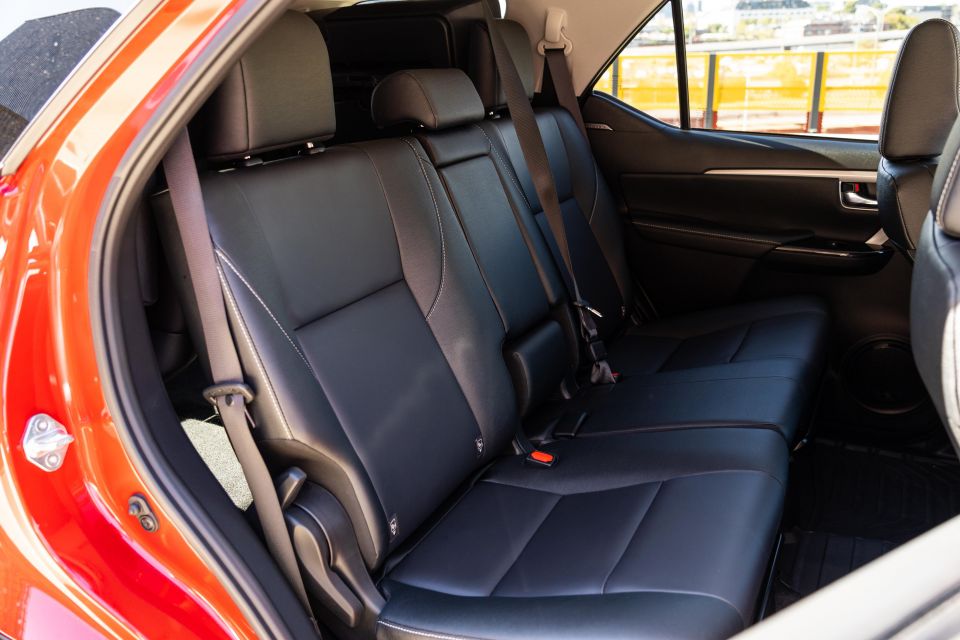
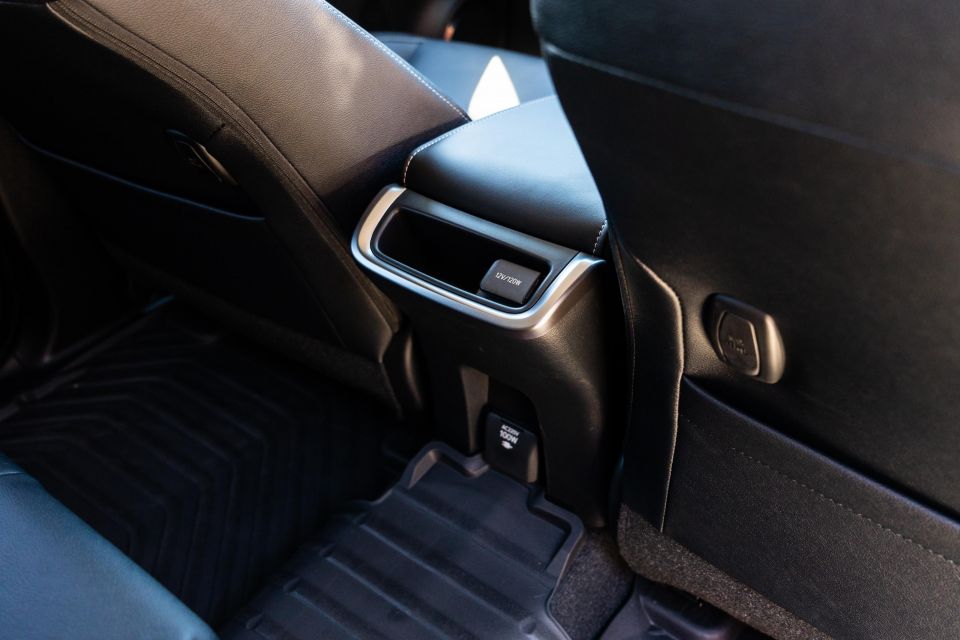
Second row space is fine without being standout. Leg room is good, though head room and toe room are on the tighter side for the segment.
There are roof-mounted air vents, plus cupholders, a coat hook, foldable grab handles, and both 12V and 220V power outlets.
Other amenities include map pockets, a fold-out centre armrest, as well as ISOFIX child seat anchors on the outboard seats.
The fold-out third row is also on the smaller side, and best left for kids. But the fact that these remain units that fold into the sides of the boot area means you’re limited for boot space as well as visibility out of the rear quarter windows.

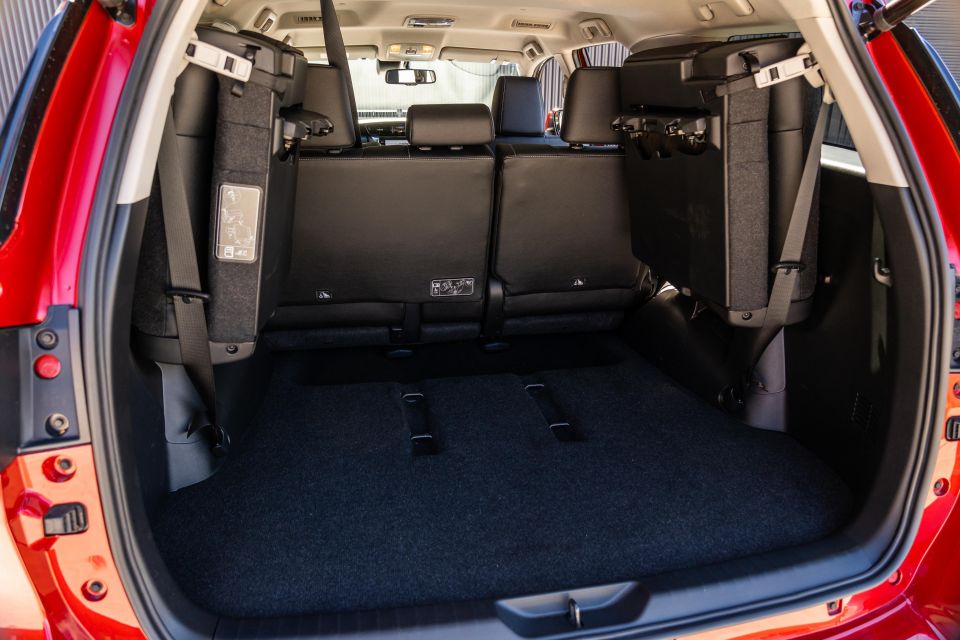
Toyota doesn’t actually state a boot capacity figure for the Fortuner, but independent figures quote 200L with the third row in use, 716L with the third row folded, and 1080L with the second row folded. As you can see from the images, it’s quite hindered by those rear seats when they’re not in use.
You also get a full-size spare wheel, which is an 18-inch alloy unit in the Crusade and a 17-inch steel unit in lower grades.
| Dimensions | Toyota Fortuner Crusade |
|---|---|
| Length | 4795mm |
| Width | 1855mm |
| Height | 1835mm |
| Wheelbase | 2745mm |
| Cargo capacity | 200-1080 litres |
To see how the Fortuner lines up against the competition, check out our comparison tool.
The Fortuner is powered by the same 2.8-litre turbo-diesel as the HiLux and LandCruiser Prado.

| Model | Toyota Fortuner |
|---|---|
| Engine | 2.8-litre 4cyl turbo-diesel |
| Power | 150kW (3000-3400rpm) |
| Torque | 500Nm (1600-1800rpm) |
| Transmission | 6-speed automatic |
| Driven wheels | Four-wheel drive (2H, 4H, 4L) |
| Weight | 2110kg (kerb) |
| Fuel economy (claim) | 7.6 litres per 100km |
| Fuel economy (as tested) | 9.9 litres per 100km |
| Fuel tank size | 80 litres |
| Emissions | 201g/km |
| Kerb weight | 2190kg |
| Gross vehicle mass | 2800kg |
| Braked towing capacity | 3100kg |
Our observed fuel figure from the Fortuner’s trip computer came about from mixed driving including peak-hour commuting, which isn’t really this vehicle’s favourite conditions. Still, it came in under the 10L/100km mark.
To see how the Fortuner compares with the competition, check out our comparison tool.
Kind of like a HiLux, naturally…

The Fortuner fires up with a diesel grumble and feels suitably old-school from the get-go compared to something like an Everest. It definitely gives off more of a workhorse vibe.
Clatter is adequately subdued but it never really goes away, and the heavy and clunky controls are a reminder of the Fortuner’s age and its agricultural roots. But for many, that will be a good thing.
With the more muscular 500Nm tune introduced in 2020, the Fortuner is still competitive with four-cylinder diesel benchmarks including the Everest Bi-Turbo, and offers more pep on paper than the Isuzu MU-X.
The 2.8-litre oiler has been around for years, powering hundreds of thousands of HiLux and Prado vehicles, as well as Fortuners and HiAces. Combined with the standard six-speed auto in this off-road 4×4 wagon, it offers strong and relatively smooth progress.

Around town it’s got that sort of relaxed, lazy vibe that a lot of ladder-frame SUVs have in daily driving.
It’ll get a bit shouty if you work it hard, but it also has enough grunt to get you up to freeway speeds or perform overtakes with relative ease. In our recent 4WD SUV Mega Test, the Fortuner proved itself to be one of the better performing four-cylinder diesel options in the segment – it beat all its direct rivals in performance testing bar the Everest Bi-Turbo.
The heavy hydraulic steering isn’t super-friendly in carparks or urban environments, but it at least feels accurate and offers decent feedback. Buyers of the Crusade trim also get a 360-degree camera that makes placing this 4795mm long, 1855mm wide family wagon a little easier in tighter spaces.
Can’t really complain about general visibility either. The mirrors are big, as are the windows, and it’s all pretty high off the ground so you have a good view out.

Like most ladder-frame 4x4s, the Fortuner feels more at home on the open road, where it can lean on its torque-rich drivetrain and soft tuning to eat up highway miles without any stress.
The diesel engine settles nicely into the background with the auto transmission in sixth, and there’s generally good insulation from road noise. Wind noise can be a little noticeable off those chunky side mirrors, though.
Fuel use on the highway will drop dramatically but, given the Fortuner still lacks idle stop/start tech, predominantly city and urban use will see the indicated readout approach 10L/100km and beyond.
The steering can feel a touch vague at speed, particularly about-centre, meaning you’re often making very small corrections to keep it heading straight. It can feel a touch boaty – no more so than an equivalent HiLux, but definitely more so than newer rivals like the latest Everest, Isuzu MU-X and even the Mitsubishi Pajero Sport.

While Toyota has done well to continually update the Fortuner with active safety systems over the years, the tech suite still isn’t a patch on the Everest and MU-X.
As we’ve mentioned with other ladder-frame Toyotas still fitted with hydraulic steering and yet to migrate to the newer TNGA-F architecture, the Fortuner’s lane keep assist via braking is often overzealous and can be unsettling when the vehicle suddenly jabs one of its inside wheels and veers away from the lane marking it thinks you’re about to drift over.
This is exacerbated by the Lane Trace Assist function that’s meant to actively keep the Fortuner centred in its lane. If anything, it’s just constantly twitching and making corrections, which doesn’t inspire confidence.
I rarely have to do it these days, but I often found myself fully taking over and doing all of the steering work myself on anything other than perfectly straight marked freeways.
Blind-spot monitoring and rear cross-traffic alert are handy inclusions, though they shouldn’t be limited to the Crusade and their audible warning is an annoying high-pitched beep that will make you wince each time it sounds.




Where expert car reviews meet expert car buying – CarExpert gives you trusted advice, personalised service and real savings on your next new car.
The Toyota claws back ground off-road, where its capable DNA shone through at last year’s 4WD SUV Mega Test. Here’s a rehash of what we found:
“The Fortuner slipped back slightly on the rollers in 2H, before the traction control figured things out. It barely moved back at all in 4H, driving off with a minimum of fuss.
“Body rigidity was impressive in our flex test, with no catching from the door.
“After a hint of wheelspin from the hanging wheels, the traction control did a good job of allowing the Fortuner to clamber out of the offset moguls. Like the HiLux, the Fortuner went about its business with a minimum of fuss.
“It effortlessly scaled Mogul Mountain in 4L with the rear differential unlocked, even on highway tyres.”
| Off-road dimensions | Toyota Fortuner Crusade |
|---|---|
| Ground clearance | 216mm |
| Approach angle | 29 degrees |
| Departure angle | 25 degrees |
| Ramp breakover angle | 23.5 degrees |
| Wading depth | 700mm |
To see how the Fortuner compares with the competition, check out our comparison tool.
Three grades are available – we have the flagship Crusade on test.




Fortuner GX highlights:
Fortuner GXL adds:
Fortuner Crusade adds:
The mid-range GXL is available with an optional package.

Premium Interior Option Pack: $2500
The Fortuner has a five-star ANCAP safety rating based on 2019 testing of the related HiLux ute.

| Category | Toyota Fortuner |
|---|---|
| Adult occupant protection | 95 per cent |
| Child occupant protection | 84 per cent |
| Vulnerable road user protection | 88 per cent |
| Safety assist | 78 per cent |
Standard safety systems include:
Fortuner Crusade adds:
The Fortuner is covered by Toyota Australia’s five-year, unlimited-kilometre warranty. Keep to your service schedule, and Toyota will warrant the engine and driveline for up to seven years.

| Running costs | Toyota Fortuner |
|---|---|
| Warranty | 5 years, unlimited kilometres – vehicle 7 years – extended engine, driveline |
| Roadside assistance | From $99 per year |
| Service intervals | 6 months or 10,000 kilometres |
| Capped-price servicing | Up to 3 years or 60,000 kilometres |
| Total capped-price service cost | $1740 |
To see how the Fortuner compares with the competition, check out our comparison tool.
The top-spec Fortuner has its merits, but doesn’t feel like the best pick of the range, nor the segment in which it competes.

It rides on proven underpinnings, and offers the peace of mind that comes with buying a Toyota. It’s also not as bulky as the Prado if you’re keen on more city-friendly dimensions.
But really, that’s where its good fortunes start to end. The Fortuner is not as powerful or practical as segment benchmarks, and it’s really starting to fall behind on the tech front.
It’s also not all that refined, and the driving experience is a bit heavy and old-hat. Maybe that’s why so many Australians just leapfrog the Fortuner and head straight to the Prado, the all-new version of which will make the disparity even more apparent.
Then again, the redesigned Fortuner will also be a much better vehicle and could finally be a solid contender at the value end of its class. We’ve seen plenty of excellent advancements with Toyota’s TNGA-F platform, and the inevitable migration of the Fortuner to it should address the current model’s key shortcomings.
So a new Fortuner cannot come soon enough for Asian markets including Australia. Perhaps better still, just bring North America’s new 4Runner here already!

Interested in buying a Toyota Fortuner? Get in touch with one of CarExpert’s trusted dealers here
Click the images for the full gallery
Where expert car reviews meet expert car buying – CarExpert gives you trusted advice, personalised service and real savings on your next new car.
James is an automotive journalist based in Melbourne, Australia. Before joining CarExpert.com.au in 2020, James has worked at leading auto media outlets including Carsales and CarAdvice, as well as at Pulse agency for Ford Australia's communications team. In 2019 James made Mumbrella's 'Top 20 most prolific web authors in Australia' list after publishing 1,360 articles between March 1, 2018 and February 28, 2019 for CarAdvice. James is also an Ambassador for Drive Against Depression – an Australian charity whose mission is to support mental wellness through the freedom of driving and a shared love of cars.


Paul Maric
6 Days Ago


Anthony Crawford
5 Days Ago


Max Davies
4 Days Ago


James Wong
3 Days Ago


James Wong
2 Days Ago
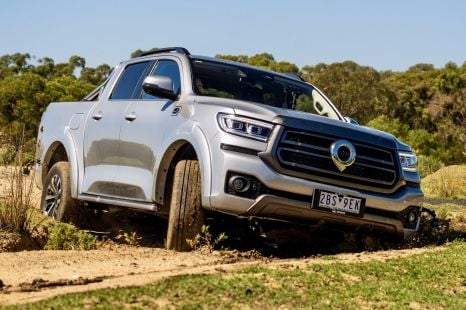

Max Davies
1 Day Ago